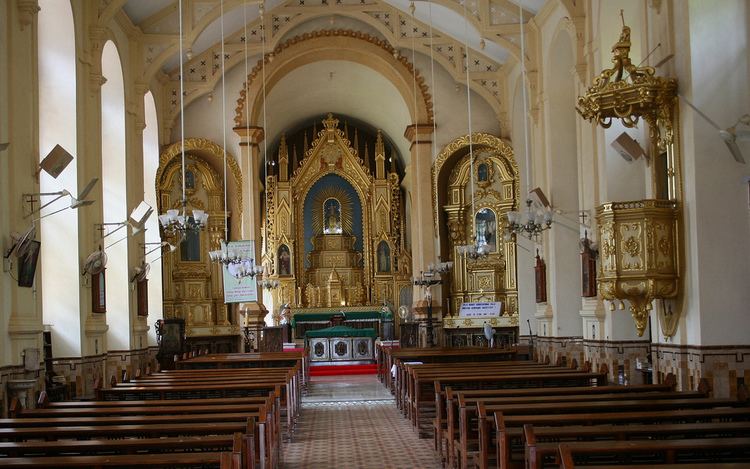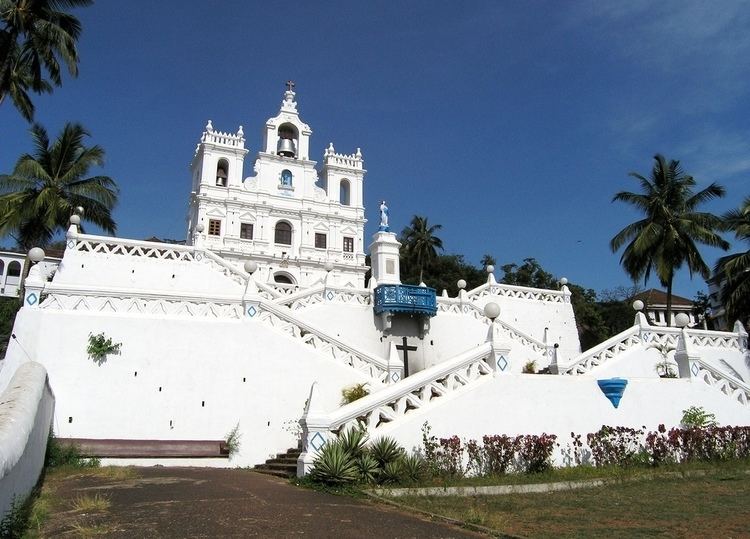Criteria ii, iv, vi | Type Cultural Reference 234 Inscription 1986 (10th Session) | |
Similar Group of Monuments at Mahab, Champaner‑Pavagadh Archaeological Park, Great Living Chola Te, St Francis of Assisi church - G, Basilica of Bom Jesus | ||
Churches and convents of goa unesco nhk
Churches and convents of Old Goa refers to the name given by the UNESCO to a set of religious monuments located in Goa Velha (or Old Goa), in the state of Goa, India, and which have been declared a World Heritage Site in 1986.
Contents
- Churches and convents of goa unesco nhk
- History
- Igreja de Nossa Senhora do Rosrio
- S Catedral of Goa
- Basilica of Bom Jesus
- Church of St Francis of Assisi
- Chapel of Santa Catarina
- Ruins of the Church of St Augustine
- Church of Divine Providence So Caetano or Saint Cajetan
- References

Goa was capital of Portuguese India and Asia and an evangelization center from the sixteenth century. The justifications for the inclusion of religious monuments in Goa in the World Heritage List are: 1) the influence of the monuments in the dissemination of Western art forms – the Manueline styles, Mannerist and Baroque – throughout Asia where Catholic missions were established; 2) the value of the set of monuments of Goa as an exceptional example that illustrates the work of evangelization and 3) the specific value of presence in the Basilica of Bom Jesus of the tomb of Francisco Xavier, which illustrates a major world event: the influence of the Catholic religion in Asia in the modern era.

History

The city of Old Goa was founded in the fifteenth century by the Sultanate of Muslim rulers of Bijapur as a port on the banks of the Mandovi river. The village was taken in 1510 by Afonso de Albuquerque, the first Portuguese Viceroy of India, with the help privateer Timoja, remaining almost continuously under Portuguese rule until the twentieth century.

Jesuits, Franciscans missionaries and other religious orders settled in Goa since the sixteenth century, used it as a center for the spread of Catholicism in India. The settlers were initially tolerant to Hinduism and other religions, but from 1560 the spread of Catholicism was reinforced by the arrival of the Inquisition in Goa, much feared in its time. The sixteenth and seventeenth centuries were the golden age of Goa, which ran a flourishing trade and came to have administrative privileges similar to those of Lisbon. In the first two centuries of the Portuguese presence most of the churches and monasteries were erected that still populate the city, earning the admiration of travelers who passed through Goa. These monuments reflect the cultural exchange between Portuguese and India: while the architectural forms follow the European canon, the internal decoration of altars, altarpieces, paintings and furniture reflect the labour, the work of local artists. This was made possible by the great tradition of Indian artists and sculptors of the Goa region, which made it not necessary to import large-scale labor-artistic work, but as occurred in colonial Brazil.
From the late seventeenth century, trade competition with Dutch and British led to the economic decline of Old Goa, at the same time that Brazil has become the most important colony to Portugal. Also, several epidemics ravaged the city and the river Mandovi port became inadequate for the more modern ships. The Viceroy moved to Panjim (New Goa) in 1759, and Old Goa lost the capital status officially in 1843.
In the twentieth century, after several years of hostilities and diplomatic negotiations, Indian troops invaded and annexed Goa and the surrounding Portuguese-held pockets to India, ending centuries of Portuguese presence in the sub-continent. The cultural influence, however, continues to this day and it is evident in religious monuments in Goa, declared World Heritage Site by UNESCO in 1986.
Igreja de Nossa Senhora do Rosário
The Church of Our Lady of the Rosary, built in 1543, is the oldest of the Old Goa churches still standing. Initially it was a parish church, then collegial. On the outside, the church looks like a small fortress; the entrance porch flanked by small cylindrical towers with cupolas is typical of late-Gothic and Manueline Portugal, particularly in the Alentejo region. Inside, it highlights the Manueline vaults of the chapels. In the chancel, besides the altarpiece dedicated to Our Lady of the Rosary, there on the wall a carved alabaster cenotaph in Persian or Indian style, with the inscription: "Aqui jaz Dona Catarina, mulher de Garcia de Sá, a qual pede a quem isto ler que peça misericórida a Deus para sua alma" ("Here lies Dona Catarina, wife of Garcia de Sa, asks those who read this to asks mercy of God for the soul.") The floor below is the grave of Garcia de Sá (died in 1549), João de Castro's successor as Governor of India. [[File:Se cathedral goa (edit).jpg|right|thumb|200x200px|Sé Catedral of Goa.]
Sé Catedral of Goa
Goa was elevated to the seat of a bishopric in 1534 by Pope Paul III, and a towering cathedral church dedicated to Catherine of Alexandria was built in the first decades of colonization. This small church, insufficient to meet the faithful, was rebuilt from 1562, during the administration of Viceroy Dom Francisco Coutinho. The construction was extremely slow, since in 1619 only the body of the church was complete, with the missing facade completed in 1631.
The See of Goa is the largest building built by the Portuguese in Asia, 91 meters long and very wide, which probably contributed to the slow pace of works. The church has three naves of equal height, shaped hall-church, as do other Portuguese cathedrals of time as the Sees of Miranda do Douro (begun in 1552), Leiria (begun in 1559) and Portalegre (begun in 1556). The severe façade with three portals, has one tower: the right was destroyed during a storm in 1766. The church naves are vaulted and separated by two rows of pillars. Interior decoration stands out the magnificent altarpiece of the chancel in gilt.
Basilica of Bom Jesus
The Society of Jesus arrived in Goa in 1542, and its most important figure in these early days was the Francisco Xavier, considered the Apostle of the East for his work in the evangelization of Asia. Some time after their arrival, the Jesuits created a religious education center, the College of St Paul or São Roque College, which had a huge library and press, but this complex was destroyed in 1830. The great Jesuit monument that survived is the Basilica of Bom Jesus, begun in 1594 and consecrated in 1605, for which worked the Goan engineer Julius Simon and the Jesuit Portuguese Domingos Fernandes. Following the model of Portuguese Jesuit churches like the Church of the Holy Spirit of Évora and the church of St Roque Lisbon, Bom Jesus is a single nave temple; this is covered by a curved wooden liner and has no side chapel except for two chapel in transepto area. The facade of the church, the work of Domingos Fernandes, is of Mannerist style and has three portals and three floors compartmentalized for cornices; On the facade there is a large body theatrically decorated by pediment with a cartouche with the arms of the Society of Jesus and flanked by scrolls.
The greatest treasure in the interior of the church is the transept chapel where lie, since 1655, the remains of Francisco Xavier, in a silver urn finely crafted by local artists. The urn is located in a mausoleum executed by the Florentine artist Giovanni Battista Foggini in 1697. This monument in Italian marble, was offered by the Grand Duke of Tuscany, Cosimo III of Medici, and set in place by a specially-sent artist Placido Francesco Ramponi, who arrived in Goa in 1698 for this purpose. The main chapel has a golden altarpiece, dating from c. 1699, dedicated to the Infant Jesus with an image of Ignatius of Loyola, the founder of the Order.
The Basilica of Bom Jesus in Goa was ranked in 2009 as one of the Seven Wonders of Portuguese Origin in the World.
Church of St. Francis of Assisi
The Franciscan Order was the first to settle in Goa, obtaining in 1517 itself the permission of King Manuel I to build a convent. The early church was completed in 1521 but was completely rebuilt from 1661. While doing so, a doorway in Manueline style, was preserved and built on Mannerist facade of the new church. This portal, made of dark stone, has a lobed profile typically manufactory and a strike flanked by armillary spheres of King Manuel symbols. The facade is narrow and high, with two towers of octagonal section. In front there is a large granite cross.
The interior has a single vaulted nave with side chapels and transept, covered by stucco and paintings. The floor of the church, like other churches of Goa, has lot of graves with inscriptions and coats. The main chapel has several paintings on the life of St. Francis of Assisi and a large gilded altarpiece dating from c.1670 with a picture of Jesus on the cross embracing with one arm Francis Xavier. Behind the altar, visible through an opening thereof, is a carved tabernacle, supported by statues of the Four Evangelists, which was used to display the Blessed Sacrament and the ciborium.
Chapel of Santa Catarina
In 1510, the troops of Afonso de Albuquerque entered the city of Goa. A chapel was built at the door of the Muslim wall of Goa, where the Portuguese invaded. This chapel was located near the site of the Royal Hospital, which stood north of the Convent of St Francis near the Arsenal.
It is a rectangular plan building with a single nave, with quadrangular head. The shape is simple and the facade with three bodies separated by pilasters. The central body has an axial port straight lintel stone with triangular pediment topped with a window flanked by two bell towers of square section and coverage gable roof. The church interior is a single nave, with the chancel of stone, with ceiling cylindrical vat, also in stone.
Ruins of the Church of St. Augustine
The Augustinians too arrived in Goa in the sixteenth century, founding a convent and a church building from 1597. Currently, both are in ruins; the vault of the church collapsed in 1842 and the facades fell in 1936. Of the remains of the church, the most striking is a part of a tower that is still standing. It is known that the original facade was flanked by two huge towers of five floors, and the domestic side was a single nave with side chapels and transept.
Church of Divine Providence (São Caetano or Saint Cajetan)
In 1639, religious of the Theatines reached Goa to found a convent. They built a church between 1656 and 1661, dedicated to St Cajetan and to Our Lady of Providence, designed by the Italian architects Carlo Ferrarini and Francesco Maria Milazzo with a plan in the form of a Greek cross. The facade, completed in 1661, mimics the facade of Carlo Maderno to St. Peter's Basilica in Rome.
